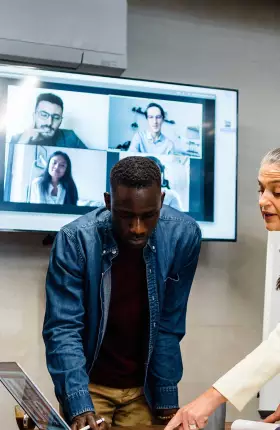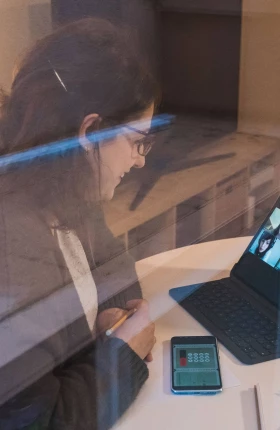First it was refusing to return to the office five days a week. Then it was trying generative AI tools without waiting for corporate guidelines. Whether or not organizations are ready for it, employees are steering change at work. Smart C-suite leaders need to work with and not against the employee-led tide. That’s according to Tsedal Neeley, an organizational behavior expert, author of the 2021 bestseller, Remote Work Revolution: Succeeding from Anywhere, and professor of business administration at Harvard Business School.
BCG Managing Director and Senior Partner Deborah Lovich, who researches the future of work as a fellow at the firm’s BCG Henderson Institute think tank, recently interviewed Neeley about how individual-led change is driving workplace innovation, including in flexible work models and the latest digital tools. Their conversation covered why organizations must stop viewing the office as a space and start thinking of it as a tool, why trust is crucial for successful hybrid distributed workplaces, and why organizations that haven’t fully embraced broad digital ways of working could get left behind when it comes to benefiting from generative AI.
Meet Deborah

Deborah Lovich: During the pandemic, so many companies found that remote work worked. Yet they're going back to the office. Why?
Tsedal Neeley: Wanting people back in office spaces is really about moving from an all-remote to a hybrid format. But that's not happening. Organizations have been stunned at the extent to which people don't want to go back to a pre-pandemic world. Office occupancy remains low. Why go into the office to find no one there? You've probably been in that situation, where you're thinking "Why am I the only one here". I know I have. Companies try to create a hybrid work culture that resembles the culture they knew pre-Covid, thinking if they did what they always did without changing systems, structures, or processes they would be successful. And that is not so.
There’s such a range of hybrid work. Some companies want people in three times a week. Some want people back 30%, 50% or 60% of the time and dictate when, while others let people decide. Is there a right answer?
There is no one-size-fits all. It has to be connected to the work of the team or group. I talk about using the office as a tool, the same way we use various technologies as tools to communicate and engage. If you see the office as a tool, you determine what specific uses it has for collaborations that require people to be physically present together. Social connections, social engagement, social bonding, and onboarding are times when it’s important for people to share physical space because you're transferring company norms, attitudes, and cultural elements to them. But asking people to fight traffic, buy that expensive cup of coffee and salad to do the exact same thing they could do at home—which is sit in front of a screen all day—is something they truly resent. They don't understand the why and so they resist. Sometimes the resistance takes the form of not going in.
Any advice for how to get it right?
You need organization-level guidelines to help people sort through when to be or when not to be in the office so there’s equity across the organization. You don't want things designed around the whims and preferences of individual managers. But you also need to ensure that managers can design what works for them within the overall guidelines.
I love how you say the office is a tool that needs to align with the work. You’re describing what I call a new managerial muscle about purposeful co-location. Like any muscle, it takes work to build it and lots of repetition.
Totally. This muscle includes knowing how to develop and sustain trust when people aren’t co-located, how to make agile teams better if they’re not co-located, how to upskill, and how to think about customers and all your stakeholders. You cannot be a mediocre manager in a virtual, distributed, or hybrid remote environment. You have to be thoughtful and disciplined. You have to set up your team and processes in new ways to be successful and effective. But once you have this muscle, it's amazing.
An issue underlying flexible work is trust. When I see companies tracking people’s badge swipes, that says "I don’t trust that you’re coming into the office."
Trust is critical to flexible work models. Likewise for managers and leaders. The trust they confer makes people perform better. It’s the reason productivity went up during the Covid era. Higher productivity has always been associated with remote work because people value autonomy—self-governing psychological independence that comes from being trusted. You trust me, so I'm going to perform for you.
So if I mandate that you have to come into the office to sit on Zoom all day and I'm measuring your badge swipes, it’s not sending the right message.
It's counterproductive. Looking at badge swipes is a privacy issue. It creates a culture of surveillance based on butts in seats. In a way, it infantilizes adult workers. Is that what you want? People are successful if, instead of micromanaging them, organizations and leaders learn how to lead a hybrid organization, equip people with trust and tools, and measure outcomes.
Let’s shift gears and talk about generative AI. How does it play into remote and hybrid work models?
Discussions about remote and hybrid work models are really about transitioning to digital work, and now that includes AI overall as well as generative AI. If you reject hybrid work or remote work, you're rejecting digital work. That is something organizations cannot afford to do. Generative AI is barreling towards us at alarming speed. It's shifting the way people work. I've heard from people experimenting with generative AI and they are doing tasks that usually take four hours in an hour and a half.
I want to make sure I understand the connection between flexible work models and generative AI. Are you saying generative AI is a natural extension of the digital tools we’re already using to work in a distributed way?
It's very much a natural extension and another form of collaboration. Collaborating with generative AI requires new digital skills, and new ways of thinking, about things like prompt engineering.
Is that another way of saying if a company cannot embrace distributed work and flexible work models, they don't have much hope of embracing generative AI?
They have to make the connection and begin changing. March 2020 was a catalyst that led to the radical transformation of work. Those who resisted have had all sorts of tensions, including not developing the productive capabilities to become more hybrid, flexible, or digital. Generative AI is individual-led compared to company-led AI. If your organization isn’t changing its approach to work, if you're not changing your operating model, if you're not upskilling your workforce to embrace a world where digital tool-enabled work is the future, you're going to be left behind.
Help me understand the distinction between individually led and organization-led change.
Until OpenAI released ChatGPT in 2022, people thought of AI as a company-led system that used data computing and algorithms to serve customers. But increasingly, it’s being used for internal management. With generative AI, in four or five steps, an individual can access this companion to help them accelerate their work and give them ideas. People who are using it say, "I can't live without my generative AI tool." AI was in the background before. With generative AI, it’s at everyone's fingertips.
What do you think of the movement to a four-day work week and asynchronous working hours?
When remote work went mainstream, people could segment their day in ways that made sense to them. If I’m remote and it’s 2 p.m. and I’m burned out and can’t think, I can take my dog for a walk, or put my laundry in the washing machine. The idea of segmenting time in a way that individuals decide autonomously is one thing people truly love about remote flexible work. During the pandemic, the Bureau of Labor Statistics reported that up to 3 million women opted out of the workforce. A big reason was not having flexibility around time. If organizations gave those women more flexibility, they could have remained in the workforce. Ultimately, it goes back to the question of trust and performance around outcomes versus "I need to look at you work all day."
A lot of executives tell me that if people are asking for flexible work so they can take care of things at home like childcare, housework or laundry they're not working.
The idea that working in a linear manner hour after hour indicates working effectively is untrue. Executives themselves don’t do that. A different perspective is, how is a person’s productivity and performance? What are their deliverables? Many people work early in the morning, after 5 p.m., or on weekends and don’t get credit for those hours. If you monitor people and think that taking two minutes to put laundry in the wash means they’re not working, that’s not a modern perspective.
Can we talk about culture? How has distributed, hybrid, or remote work changed organizations’ cultures?
Culture is an outcome of organizational design and process. It’s who the members of the organization are, the roles they play, how teams are designed, and the processes in place to get work done. Those things create culture, and culture shapes performance. If you begin with that premise, it’s obvious that remote or hybrid work has changed the culture so much: processes, how we work, how we engage one another, how we communicate, how we think about documentation, and leaders’ vision and sentiments.
The moment Covid hit, organizational cultures changed. Some got stronger. Organizations cared for their people. Employees got multiple touch points a day from leaders. Leaders’ true natures were exposed. Most organizations were incredibly wonderful and caring and supportive. Organizations had to switch to measuring outputs, not inputs. Other companies’ transitions were less effective. They didn’t adapt or absorb any knowledge around how to be effective in that environment, and their employees are not having a positive experience.
Organizations have to adapt and be open to shifting and changing. Learning is critical. If you're holding on to the way things were, it's going to play out in your organization and that's not going to be positive at a time where change is the only constant.
How do you encourage leaders to accept new ways of working?
Organizations have to be deliberate. Map out formal hybrid work plans. Train leaders and managers and team members on how to be effective hybrid employees. There is a set of known, vetted practices organizations need to put into place. Going back to generative AI, we’re at a pivotal moment. If you're not working on determining how the technology will impact your organization, your employees, clients and customers are going to start asking questions.
Featured Insights: Explore the ideas shaping the future of business
About the Author
Deborah Lovich is a BCG Managing Director and Senior Partner and, as a fellow at BCG Henderson Institute think tank, researches the future of work. (See https://bcghendersoninstitute.com/contributors/debbie-lovich/)





